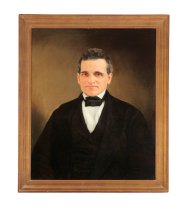Object Record
Images

Metadata
Catalog Number |
1900.001.021 |
Object Name |
Painting |
Collection |
Statehouse Artwork Collection/Governors' Portraits |
Title |
Portrait of Seabury Ford |
Artist |
Griswold, Manfred Marsden, 1819-1922 |
Date |
1869 |
Description |
Front-facing portrait of Ohio's twentieth governor, Seabury Ford (1849-1850). He wears a black coat, white shirt and black tie. |
Material |
Oil Paint/Canvas/Wood |
Notes |
Seabury Ford was born in 1801, in Chesire, Connecticut. Ford was the sixth generation of his family to live in North America. His family arrived in Massachusetts in 1637. His ancestors were among the original settlers of the colony of Connecticut. Ford's father moved the family to Burton, Ohio, in 1807. Ford returned to Connecticut to attend Yale University in 1821, but he came back to Ohio after his graduation in 1825. After graduation, Ford studied the law with his uncle, Peter Hitchcock. He was admitted to the Ohio Bar in 1827 and began to practice law in Burton. Ford married his cousin, Harriet Cook, on September 10, 1828. During their marriage, the couple had five sons. Over time, Ford became involved in the state militia and became a major general. He also joined the Whig Party during the 1830s. Geauga County residents elected Ford as a state representative in 1835. He was reelected to two additional terms and, for a time, served as the Speaker of the House. Between 1841 and 1848, Ford served as a state senator. During his time in the state legislature Ford helped to repeal the Ohio Loan Law of 1837, also known as the "Plunder Act". In 1848, Ford became the Whig candidate for governor. Ford won the closest gubernatorial election in Ohio history, which ultimately had to be decided by the state legislature. As a result, the inauguration was delayed for six weeks. Ohioans were deeply divided over the issue of slavery, and Ford had campaigned against the expansion of slavery and for the repeal of the Black Laws. Seabury Ford became Ohio's twentieth governor on January 22, 1849. He was Ohio's last Whig governor. Very little was accomplished in the legislature during Ford's term as governor. The Ohio General Assembly was divided over national issues. Ford's one great success was the repeal of the Black Laws, which had discriminated against African Americans in Ohio. The legislature also voted to hold a constitutional convention in 1850. The Ohio Constitution of 1851 was the result of this convention. Ford retired from politics and returned home to Burton after his term as governor on December 12, 1850. Less than a week after arriving home, he suffered a stroke. He spent the remainder of his life partially paralyzed and in poor health. Seabury Ford died on May 8, 1855. |
Provenance |
In 1867, the Ohio General Assembly passed a joint resolution relative to the governors of Ohio. The legislators resolved that "the secretary of state, on the first Monday of January next, whether the portraits of the governors of Ohio, state and territorial, can be procured, and if so, whether original portraits or copies, and the probable expense of procuring such portraits for the governor's office." The Executive Documents, Message and Annual Reports for 1869 shows a payment on account of Appropriation for Governor's Contingent Expenses as follows: "June 14, 1869 M.M. Griswold. . . For painting portrait of Gov. Ford $80.00" The Capitol Square Review and Advisory Board took over the care of the Statehouse and its collections in 1988. |
Image size |
32" x 26" |
Frame size |
36-1/2" x 30-1/2" |
Frame desc |
Twentieth century molded gilt frame with carved beaded liner |
People |
Ford, Seabury, 1801-1855 Griswold, Manfred Marsden, 1819-1922 Smith, William Henry, 1833-1896 |
Search Terms |
Ohio Governor Ohio Governor's Portraits |
Subjects |
Governors Painting Portrait paintings |

